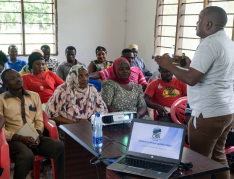
Published: JANUARY 01, 2021
Climate change threatens Tanzania’s economy due to several billion US-dollars spent every year on the recovery from extreme weather events. Financing solutions to tackle climate-induces loss and damage have to be discussed and further developed. One of the demands from the first day of the Pre-COP25 was to stress on climate financing opportunities at COP25 with the aim to strengthen African’s climate resilience. Thus, Climate Action Network Tanzania (CAN TZ) facilitated a workshop on climate financing on day two of the two days conference, held from 15th to 16th of October 2019 in Dar es Salaam. Our participants were eager to continue where we had stopped at day one and to deepen their knowledge on adaptation approaches related to financing solutions.
The objective of the climate financing workshop was to inform the participants about possible opportunities to handle loss and damage caused by the climate and to find common ground for climate insurance mechanisms.
Consultant Thomas Hirsch opened the workshop by laying a foundation for climate risk financing options, and direct as well as indirect insurance mechanisms. Climate risk insurances can be one of the options to protect either smallholders or large-scale companies from financial losses caused by extreme climate events. Hirsch presented different types of climate risk insurances and its strengths and weaknesses. Whilst an average German person has about five different insurance contracts, direct insurances for smallholders tend to be very expensive in Africa and most likely not affordable. An alternative approach can be a risk transfer to third parties: indirect insurances where governments insure their country and its population.
In general, climate risks are unequally distributed, as very poor people bare a five times higher risk to lose their life than the rich minority in a developing country. He concluded by saying that the focus should be on the vulnerable ones and that we should push for a principle of solidarity: ‘polluter pays’to secure affordability for those in need.
The second half of the morning, Hirsch presented other instruments of climate risk financing and how they can be embedded in comprehensive risk management. He offered significant information for the management of loss and damage. Climaterisks are especially high for developing countries. 19 out of 20 countries with the highest climate risks are located within Africa. Only one is in Asia which shows that economical-weak countries are even more prone to suffer from climate-induced shocks.
Slow and sudden onset events may turn into value loss in high risk zones. “At national scale, loss and damage lead to indebtedness as countries struggle to secure funds to rebuild their infrastructure”, Hirsch added. As a result, international climate risk financing instruments have to be demanded by the African community to cover the burden.
German non-governmental organisation (NGO) Bread for the World developed some policy recommendations which were presented by Hirsch. Examples are massive investments in disaster risk prevention and reduction as well as the design of new, innovative climate risk financing instruments and regional risk pools. Through policy analysis and research as well as the engagement with decision makers, NGOs can increase their participation in these political processes.
After an intensive session of Thomas Hirsch, Catherine Marimbo from the Tanzanian Prime Minister Office of Disaster Management spoke about governmental approaches to cover climate-induced loss and damage within the country. Tanzania is facing disasters which include hazards of natural as well as of human-induced nature. Marimbo gave an overview of the institutional arrangement of the PMO disaster management and their activities. The main challenges are the lack of adequate and aggregate data as well as the inadequate urban and land use planning, she reported.
The last speaker before the closing plenary discussion was Mohamed Adow from Power Shift Africa who presented examples of loss and damage in Eastern Africa. He stressed that Loss and Damage needs a separate fund from development or adaptation and that it requires a higher profile. Therefore, a roadmap to an international fund for Loss and Damage should be a prominent topic of the COP25.
It is mandatory for CAN TZ to follow-up on this year’s Pre-COP25 for a continuation of deep discussions and to build further capacities by exchanging knowledge on loss and damage. Overall, participants of Pre-COP25 in Tanzania agreed that responsibilities of climate financing as well as immediate actions have to be tackled at COP25 in Spain this year.
